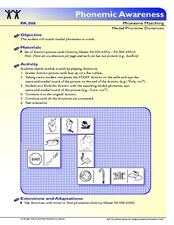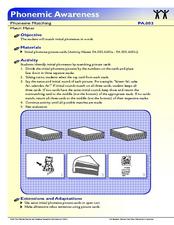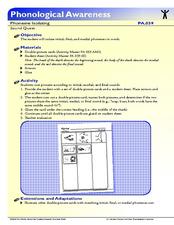Florida Center for Reading Research
Phonological Awareness: Phoneme Manipulating, What's Left?
Scholars subtract initial phonemes from given picture word cards to create new words. Feet becomes eat, and shelf becomes elf.
Florida Center for Reading Research
Phonological Awareness: Phoneme Blending, What's My Word?
At a listening station, learners listen to a pre-recorded script; they follow the directions and number each picture on their picture chart corresponding to the segmented phonemes they hear.
Florida Center for Reading Research
Phonological Awareness: Phoneme Matching, Final Phoneme Pie
Words are interesting things—you can change them by adding or subtracting phonemes. Here, emergent readers change the pictures on their phoneme pie by removing or adding various final phonemes. A fun way to build phonetic competency!
Curated OER
Phonological Awareness: Phoneme Manipulating, Name Changes
Set up a listening center, record the provided script, and see how well your class can manipulate phonemes based on the instructions you've provided. This center-based activity builds the phonological awareness and phoneme manipulation...
Curated OER
Phonological Awareness, Phoneme Manipulating, Phoneme Position Sort
Scholars make new words out of old ones by manipulating phonemes. Pupils mix and match initial, medial, and final phonemes to change words like cap into cup or head into bed.
Florida Center for Reading Research
Phonological Awareness: Phoneme Segmenting, Phoneme Hopscotch
Your class will love playing phoneme hopscotch! Scholars choose a card, say the name of the object on the card, break the word into phonemes, count the phonemes, then hop that many spaces on the hopscotch mat. Super fun!
Florida Center for Reading Research
Phonological Awareness: Phoneme Matching, Medial Phoneme Dominoes
Matching medial phonemes can be as easy as playing a game of dominoes! These dominoes contain pictures of items children can say. As they say each word aloud, they work to match the medial sound to one on an adjacent card. Just like real...
Florida Center for Reading Research
Phonological Awareness - Phoneme Segmenting and Blending, Treasure Chest
Working in pairs, scholars use picture cards to practice segmenting words into phonemes and blending phonemes into words. When a peer answers correctly they place a penny in a treasure chest. Incorrect responses make the card go back in...
Florida Center for Reading Research
Phonological Awareness: Phoneme Matching, Medial Match
Early readers get together and match medial phonemes. They take turns picking picture cards from a pile; they say each word, then determine whether the pair has matching medial sounds.
Florida Center for Reading Research
Phonological Awareness: Phoneme Segmenting, The Sound Game
Pre-readers get a better understanding of phoneme segmenting and counting by playing a board game. They pick an image card from the stack, say the name of the object, break the word down into segments, then move their piece that number...
Florida Center for Reading Research
Phonological Awareness: Phoneme Isolating, Phoneme Quest
In this phonics activity, little learners glue picture cards under the initial, medial, and final phonemes represented by the lead sound cards. An image of a shark broken into three parts represents the initial phoneme /sh/, the medial...
Curated OER
Using the Sounds of Words Reading Task
Young readers demonstrate phonemic awareness in words and blends, and recognize 100 high-frequency words. Use a nursery rhyme to point out rhyming words, and change the words by putting a new letter at the beginning. Each learner will...
Florida Center for Reading Research
Phonics: Onset and Rime, Change-A-Word
Kids use their phonological know-how to identify and segment onset and rime blends. Double rime picture cards (cat and hat) are chosen, then matched to onset cards that make each word, such as the k sound for a cat and the h sound for a...
Florida Center for Reading Research
Phonics: Encoding and Decoding, Make-A-Word
Little learners place a picture card on a magnetic board, say the name of the object on the card, then sift through alphabet magnets to find and spell the word they said.
Florida Center for Reading Research
Phonological Awareness: Phoneme Segmenting, Phoneme Photos
This great activity incorporates counting, phoneme segmenting, and class photos. In pairs, learners take turns saying, counting, and checking the number of phoneme segments found in their classmates' names. They count the phonemes and...
Florida Center for Reading Research
Phonological Awareness: Phoneme Matching, Match Maker
Pre-readers identify and match initial phonemes. Scholars take turns choosing one card from each of the three stacks. They say the name of the image on the card, then keep whichever cards have a matching initial phoneme.
Florida Center for Reading Research
Phonological Awareness: Phoneme Isolating, Sound Quest
Scholars cut, paste, and identify specific initial, medial, and final phonemes by placing them on a phoneme chart.
Florida Center for Reading Research
Phonemic Awareness: Phoneme Matching, Sound Pictures and Picture Puzzles
Scholars use a T-chart and puzzle pieces to practice saying and recognizing the medial sound in a series of words. Peers take turns choosing a puzzle piece, saying its name and medial sound, then placing it on their side of the chart.
Florida Center for Reading Research
Phonological Awareness: Phoneme Matching, Pack-a-Backpack
Scholars sort words based on their initial phoneme or sound. Learners are given two backpacks, each with a picture card; they search and match picture cards with the same initial sound as the ones on each backpack.
Florida Center for Reading Research
Phonological Awareness: Phoneme Matching, Sound Bags
Peers pair up to find, identify and match medial phonemes. Peer one pulls a card or object from a bag, names it, then says its medial sound.—peer two attempts to find a picture or object whose medial sound matches the partner.
Florida Center for Reading Research
Phonological Awareness: Phoneme Matching, Sound Maker - Sound Smacker
Scholars sort words based on their initial phonemes. They choose cards, say their names, and match the initial phoneme to the one posted on one of the sorting bins. If the initial sound matches, they put the card in the sound maker bin,...
Florida Center for Reading Research
Phonological Awareness: Phoneme Matching, Sound Train
Make a phonics train filled with matching initial phonemes. Early readers say the name of the objects on each of their cards, identify the initial letter sounds or phonemes, then paste them on a train. They make three trains, which means...
Florida Center for Reading Research
Phonological Awareness: Phoneme Matching, Sound Pie
Develop phonological awareness by challenging pupils to recognize final sounds in familiar words. Using magazines or other print resources, scholars search for pictures of words with the same final sound as a starter picture. Once they...
Florida Center for Reading Research
Phonological Awareness: Phoneme Isolating, The Last Sound Is...
Partners work with real objects as they practice final phonemes. Here's how it works: Partner A silently chooses an object and sounds it out, determining the final phoneme and saying the sound aloud. Partner B examines the group of...

























